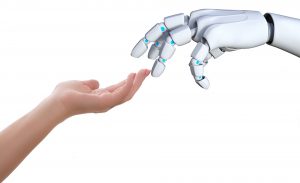
Today’s market size shows the revenues from smart robots in 2017 and projected for 2025. Because of their accuracy and efficiency, smart robot adoption is significantly higher in the manufacturing, automotive, healthcare and retail industries. Smart robots for manufacturing dominated the industrial segment of the market in 2017. Smart vacuum cleaners constituted most of the residential segment. Growth in this segment is expected to come from increased demand for other types of smart household cleaning machines (mopping, lawn mowing, pool cleaning) as well as for smart vacuums.
Mobile robots and robots used in a healthcare setting comprise the majority of the professional services segment. Autonomous mobile robots can dynamically re-route themselves due to their advanced sensory and enhanced intelligence systems. As a result no special infrastructure alterations are needed to deploy these devices. This capability gives them an advantage over autonomous guided vehicles that have been used mainly for warehouse distribution and logistics applications. Smart robots used in a healthcare setting are helping doctors perform surgery, disinfecting hospital rooms, providing precise radiation therapy for cancer treatment, and transporting meals, linens, lab samples, waste and other items throughout hospitals. Smart robots such as PARO, a fuzzy, baby harp seal-shaped therapeutic robot, provide comfort, reduce stress, and help improve the socialization skills of people with dementia and similar conditions.
Since the outbreak of COVID-19, disinfection robots have been in high demand. Chinese hospitals have ordered more than 2,000 UVD robots from Blue Ocean Robotics alone. These robots move autonomously around patient and operating rooms using UV-C light to kill 99.99% of viruses and bacteria throughout the room in about 10 minutes. If a person enters the room, the robot automatically shuts off the UV-C light. A device such as this can also be used in offices, schools, shopping malls, airports, and manufacturing facilities.
Notwithstanding the demand caused by COVID-19, growth in the overall smart robot market is expected to be caused by several factors: increasing demand for service robots, increasing adoption of artificial intelligence and Internet of Things applications, falling prices due to innovation and a proliferation of the technology, and the use of robotics in mobile and other smart devices. Government and venture capital funding for smart robots and related technologies is also expected to enhance demand in the near future. Leading manufacturers include ABB Ltd; iRobot Corp.; Kuka AG; Fanuc Corp.; Yaskawa Electric Corp.; Panasonic Industry Europe GmbH; OTC Daihen Inc.; Kawasaki Heavy Industries; Intuitive Surgical Inc.; and Omron Adept Technologies, Inc.
1 See also our Collaborative Robots post.
Geographic reference: World
Year: 2017 and 2025
Market size: $4.06 billion and $17.56 billion, respectively
Sources: “Smart Robot Market by Component (Hardware and Software), Application (Welding & Painting, Assembling & Disassembling, Mobility, Inspection & Security and Others), Industry Vertical (Automotive, Manufacturing, Electrical & Electronic, Food & Beverage, Chemical, Residential, and Others) – Global Opportunity Analysis and Industry Forecast, 2018-2025,” Allied Market Research Report Overview, June 2018 available online here; “Smart Robots Market Size, Share & Trends Analysis Report by Component (Hardware, Software, Service), by Application, by End Use (Industrial, Commercial, Residential), by Vertical, by Region, and Segment Forecasts 2018-2025,” Grand View Research Report Summary, October 2018 available online here; “5 Medical Robots Making a Difference in Healthcare,” Case Western Reserve University, Case School of Engineering, December 28, 2017 available online here; “Executive Summary World Robotics 2019 Service Robots,” International Federation of Robotics, September 18, 2019 available online here; Bennett Brumson, “New Applications for Mobile Robots,” Robotics Industry Insights, April 5, 2012 available online here; Angela Johnston, “Robotic Seals Comfort Dementia Patients But Raise Ethical Concerns,” KALW, August 17, 2015 available online here; “Robots Help to Fight Coronavirus Worldwide,” International Federation of Robotics Press Release, March 31, 2020 available online here; “PARO Therapeutic Robot” available online here.
Image source: Pete Linforth, “connection-hand-human-robot-touch-3308188,” Pixabay, April 10, 2018 available online here.
